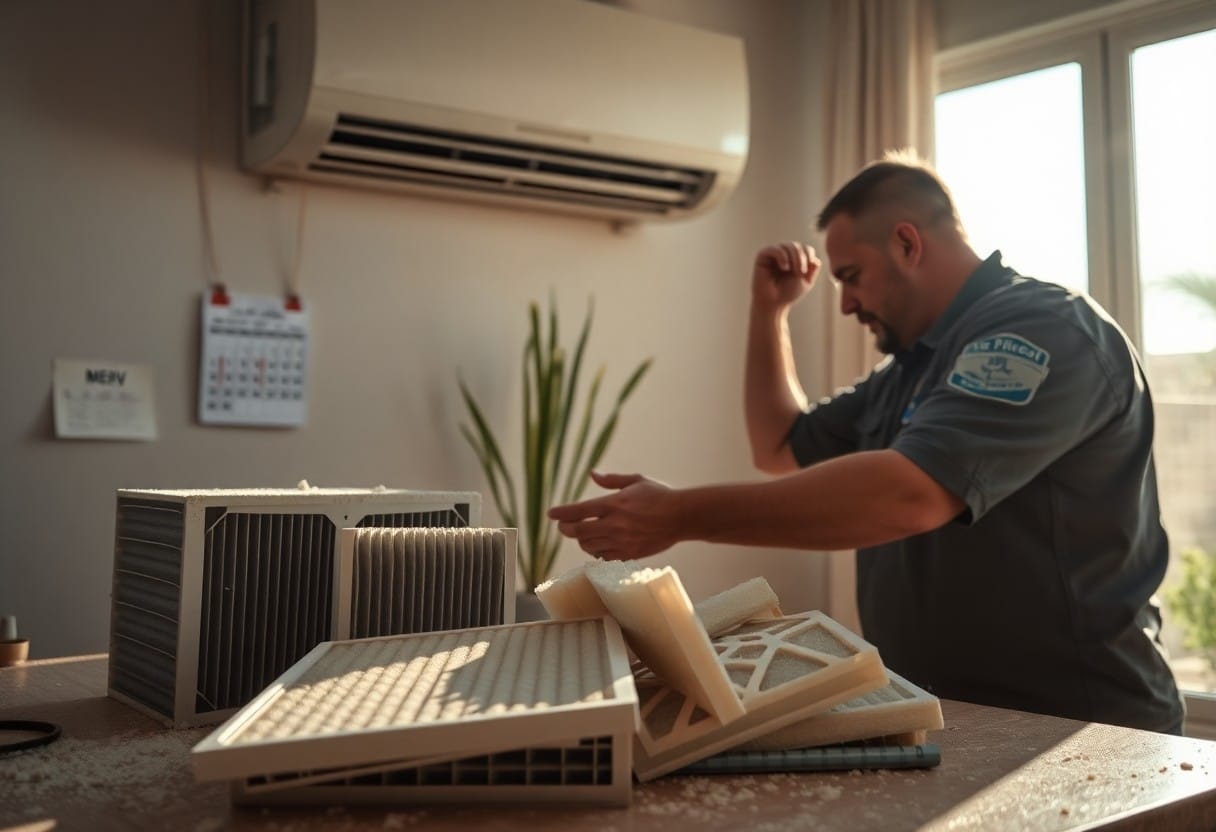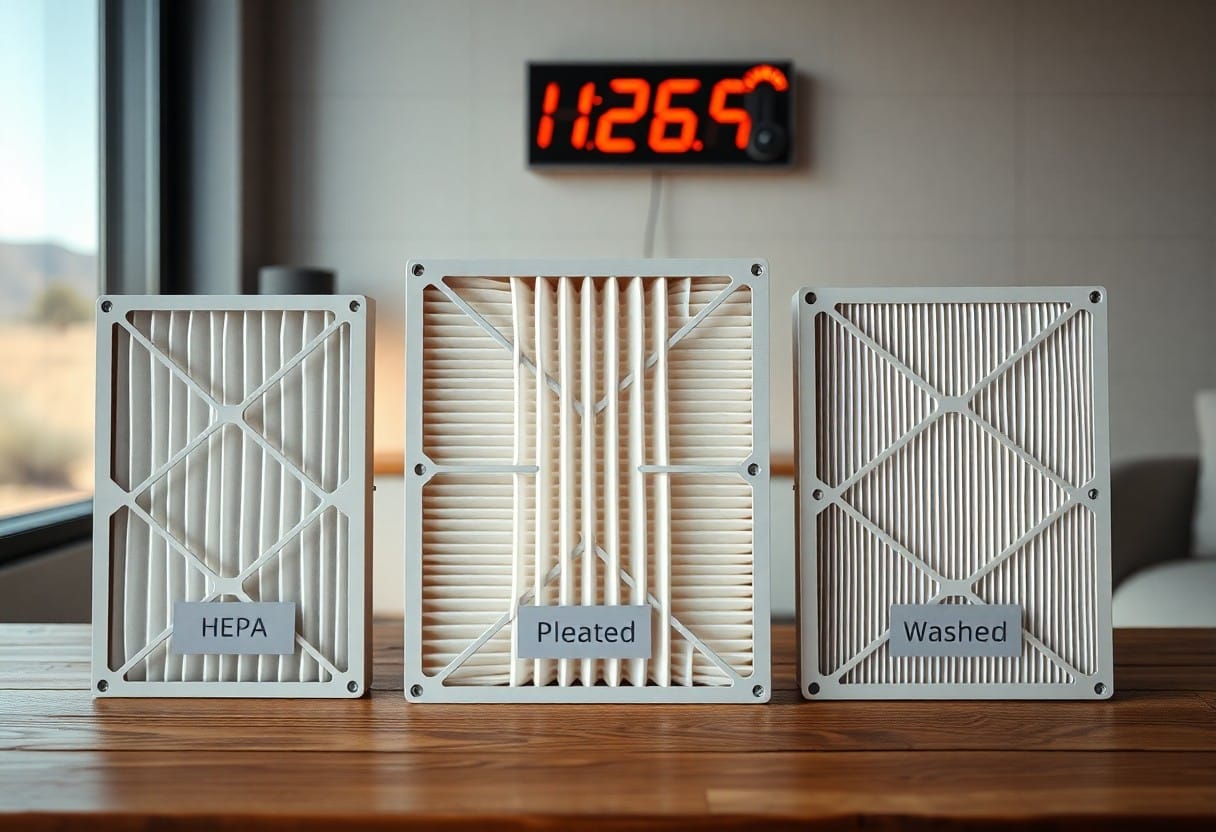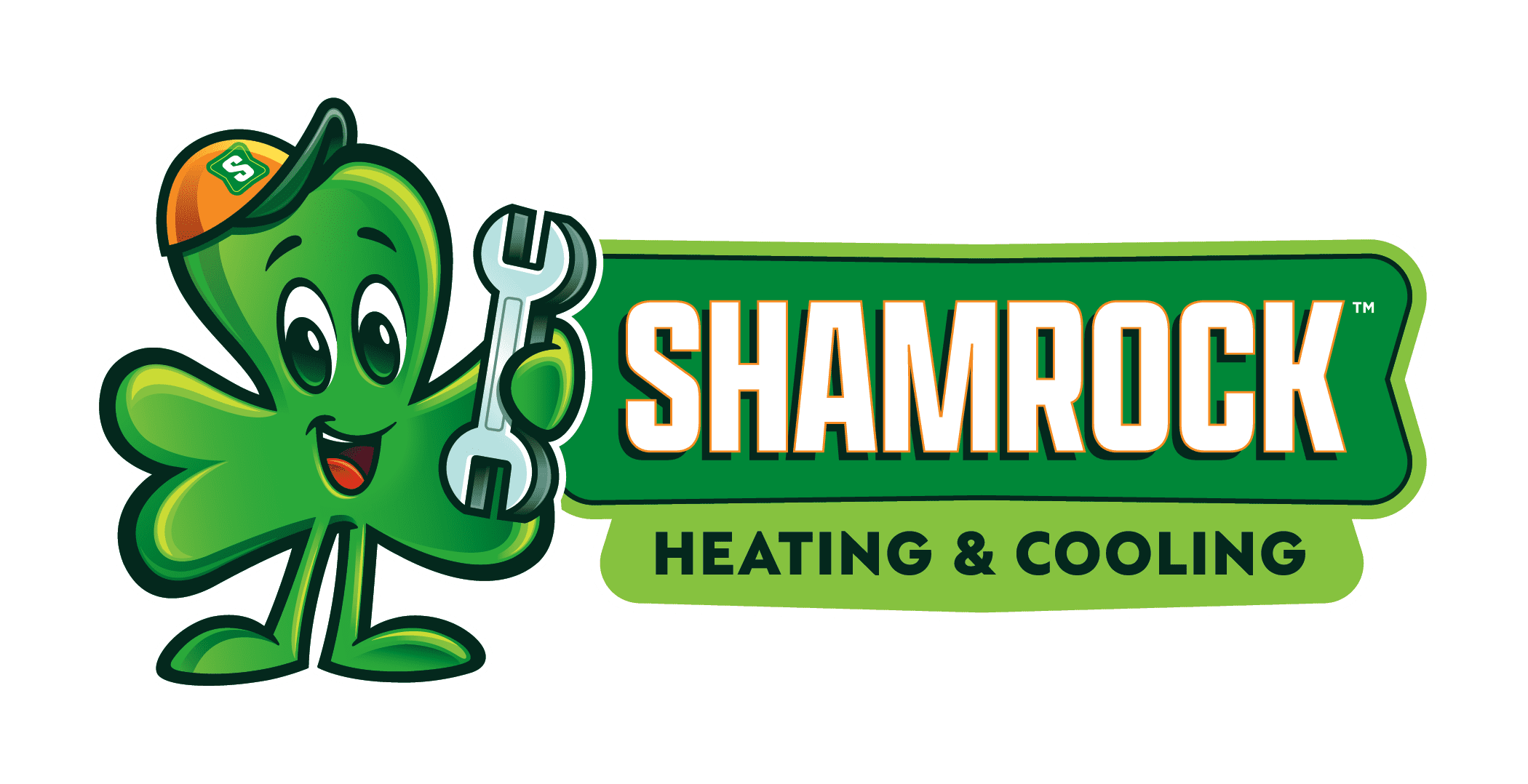Many homeowners in Phoenix underestimate the impact of frequent HVAC filter changes in the summer months. With high temperatures and persistent dust in the air, it’s necessary to regularly replace your filters to maintain optimal air quality and system efficiency. Neglecting this can lead to reduced system performance, higher energy bills, and potential damage to your HVAC system. This guide will provide you with the recommended frequency for changing your filters to ensure your home stays comfortable and your system runs smoothly throughout the hot summer days.
Types of HVAC Filters
In Phoenix’s dusty climate, selecting the right type of HVAC filter is imperative for maintaining indoor air quality. Filters are classified primarily by their construction materials and efficiency ratings. Understanding these types can assist you in making informed decisions for your home.
- Fiberglass Filters – Basic filtration, inexpensive
- Pleated Filters – Enhanced filtration, better air flow
- HEPA Filters – High efficiency, captures small particles
- Electrostatic Filters – Charged particles, reusable
- Washable Filters – Eco-friendly, long-lasting
| Type | Description |
| Fiberglass Filters | Basic filtration with low efficiency. |
| Pleated Filters | Traps more airborne particles due to increased surface area. |
| HEPA Filters | Removes 99.97% of particles down to 0.3 microns. |
| Electrostatic Filters | Utilizes static charge to capture small particles. |
| Washable Filters | Reusable option that’s environmentally friendly. |
Fiberglass Filters
Fiberglass filters, often the most affordable option, consist of a mat of randomly arranged fiberglass fibers. They are designed primarily to protect HVAC equipment rather than improve air quality. While they can capture larger particles such as dust and lint, their efficiency ratings are typically very low, often around MERV 1-4. If you live in a particularly dusty area of Phoenix, these filters may require frequent replacement to avoid restricting airflow.
Despite their low cost, relying solely on fiberglass filters could lead to increased utility bills and equipment strain. Consider pairing them with a secondary filtration system or upgrading to a higher-rated filter for better airflow and air quality. Any consideration of maintenance should include how these filters can impact the overall efficiency of your HVAC system.
Pleated Filters
Pleated filters feature a larger surface area compared to fiberglass filters, allowing them to capture more particles effectively. With a typical efficiency rating of MERV 5-13, they trap dust, pollen, pet dander, and much smaller particles. Their construction facilitates improved airflow, which is crucial in maintaining your HVAC system’s efficiency during the hot Arizona summers.
The design of pleated filters enables them to filter air much more effectively than fiberglass options. This means less workload on your HVAC system, which can lead to reduced energy bills and extended equipment life. Maintaining these filters—by changing them every 1-3 months—is necessary to ensure optimal performance. Any lapse in this can diminish their filtration effectiveness, potentially impacting your indoor air quality.
Reusable pleated filters are also available, providing a sustainable option with reduced long-term costs. However, regular maintenance to keep them clean is imperative to ensure that they continue performing at their best.
HEPA Filters
High-Efficiency Particulate Air (HEPA) filters are among the most efficient available, designed to capture 99.97% of particles as small as 0.3 microns. They are particularly beneficial for those with allergies, asthma, or respiratory issues, as they significantly reduce the presence of airborne irritants such as mold spores, dust mites, and pet dander. In areas like Phoenix, where extreme heat and dust can compromise indoor air quality, investing in HEPA filters can be a game changer for your home’s air environment.
HEPA filters typically come with a higher price tag and require more substantial airflow from your HVAC system. Furthermore, regular maintenance is imperative; changing or cleaning these filters at the manufacturer’s recommended intervals will ensure that they maintain their high efficiency and do not cause strain on your HVAC system. Any neglect in filter changes can rapidly diminish their effectiveness, leading to a less breathable indoor environment.
Frequency of Filter Changes
Seasonal Recommendations
In Phoenix’s extreme climate, changing your HVAC filter regularly is vital for maintaining indoor air quality and system efficiency. During the summer months, when dust storms are more prevalent, you should aim to replace your filter every month. If you experience heavy usage due to high temperatures or frequent cooling cycles, it may be necessary to check the filter more often. How Often Should You Change Your HVAC Filter? gives further insights into this practice.
In the milder months, such as spring and fall, you might extend the replacement interval to every 2-3 months. However, keep an eye on your filter’s condition—if you notice it looking dirty sooner than expected, a change is warranted regardless of the season. Your HVAC system will operate more efficiently, effectively cooling your space while reducing energy costs.
Factors Affecting Frequency
Several factors influence how often you should change your HVAC filter. The type of filter you use is significant; pleated filters generally require changing less frequently than fiberglass filters. The presence of pets or children in your home can also necessitate more frequent changes due to increased dander and dust. Additionally, air quality in your neighborhood plays a role; if you live in a particularly dusty area, you may find that your filters clog up faster.
Other factors include your system’s operational hours and maintenance routines. If your HVAC system runs continuously or cycles often due to extreme weather, you’ll require more frequent changes. Regularly inspecting your filter every month can help you gauge the need for replacement. You might also consider scheduling professional maintenance, which can further help in identifying the best timeframe for filter changes. Recognizing these factors helps to maintain your home’s air quality and prolongs the life of your HVAC system.
- Type of filter
- Presence of pets or children
- Air quality in your area
- System operational hours
- Professional maintenance schedules
Regular inspection of your HVAC filter is crucial for determining its condition and necessary replacements. Filters might require more frequent changes during events like dust storms or when your system is used often. If you notice increased dust accumulation or changes in airflow, it’s time to take action. Recognizing these indicators will ensure your HVAC systems continue to perform optimally.
- Increased dust accumulation
- Changes in airflow
- Frequent system usage
- Presence of outdoor pollutants
- Indoor air quality concerns

Tips for Choosing the Right Filter
Selecting the appropriate HVAC filter goes beyond simple compatibility with your system; it also involves understanding your household’s specific needs. Not all filters are created equal, and your choice should depend on various factors, such as allergies, pets, and overall air quality. When looking for a new filter, consider filters with a balance of filtration efficiency and airflow. High-efficiency filters capture more dust and pollutants, potentially enhancing your indoor air quality. Examine product specifications carefully and opt for a filter that meets your requirements without overly restricting airflow.
- Evaluate your home’s specific needs.
- Check the filter’s MERV rating.
- Consider the price and lifespan.
- Look for antimicrobial or hypoallergenic options.
- Assess the filter’s compatibility with your HVAC system.
After selecting the right filter, make a note of when it needs to be changed to maintain optimal performance.
MERV Ratings Explained
MERV, or Minimum Efficiency Reporting Value, measures a filter’s ability to capture particles of different sizes. The scale ranges from 1 to 16, with higher ratings indicating better filtration efficiency. For instance, a filter with a MERV rating of 8 is suitable for capturing average household particles, including dust and pollen, while a rating of 13 or higher is recommended for individuals with allergies. In Phoenix, where dust storms are common, choosing a filter with a minimum MERV of 8 or even higher can significantly improve the air quality in your home.
Pay attention to your system’s specifications; some HVAC units may not support high-MERV filters due to increased airflow resistance. Therefore, understanding this balance helps ensure you maximize your filter’s effectiveness without compromising your HVAC system’s performance.
Budget Considerations
When opting for an HVAC filter, budgeting plays a pivotal role in your decision-making. While high-efficiency filters tend to be more expensive, they can lead to long-term savings by reducing energy costs and extending the lifespan of your HVAC system. Weigh the upfront cost against the potential benefits. Filters that you change less frequently may cost more upfront but can save money in the long run due to their efficiency and reduced wear on your unit. On average, a high-quality filter may cost between $15 to $50, but consider the value it brings to your health and comfort.
After evaluating different options, consider setting a budget that balances quality and cost-effectiveness. While lower-priced filters may seem appealing, investing in a medium to high-range filter can significantly enhance indoor air quality, ensuring you breathe cleaner air while potentially saving on energy bills and HVAC maintenance in the future.
Step-by-Step Guide to Changing Filters
Tools Needed
You’ll find that changing your HVAC filters requires minimal tools. Generally, a simple flathead screwdriver or a pair of pliers can suffice, depending on your unit. Keep a vacuum cleaner on hand to remove any dust and debris around the filter area. Additionally, having a clean workspace will make the task easier and more efficient.
| Tool | Purpose |
| Flathead Screwdriver | For removing any screws if necessary |
| Pliers | For gripping and pulling out the filter |
| Vacuum Cleaner | To clean dust around the filter area |
Process Overview
Start by turning off your HVAC system completely. This prevents any airflow complications during the process and allows you to handle the filter safely. Next, locate the filter compartment, which may be at the return air duct or in the air handler unit. Once you’ve found it, carefully open the compartment to access the filter.
Pull the old filter out gently to avoid releasing accumulated dust back into the air. Before inserting the new filter, take a moment to inspect the compartment for any trapped debris and clean it thoroughly. Be mindful of the correct orientation of the filter, as indicated by arrows on its side, ensuring it aligns with the air flow direction.
This step is simple yet vital; checking the filter size and ensuring a snug fit prevents air leakage that can reduce HVAC efficiency. Use the measurements you noted earlier to select the right replacement filter, and consider higher MERV-rated filters if your unit allows, as they can improve indoor air quality significantly.

Pros and Cons of Different Filter Types
Pros and Cons of Different Filter Types
| Filter Type | Pros | Cons |
|---|---|---|
| Fiberglass | Inexpensive, easy to find | Low efficiency, needs frequent replacement |
| Pleated | Higher efficiency, longer lifespan | Higher cost, may restrict airflow |
| HEPA | Removes 99.97% of particles, excellent for allergies | Higher cost, requires compatible HVAC systems |
| Electrostatic | Reusable, can trap more dust | Needs washing, can lose efficiency over time |
| Carbon | Reduces odors, effective in air purification | Can be expensive, less effective for particulates |
Advantages
Pleated filters offer significant advantages in filtration efficiency, capturing more dust and allergens compared to their fiberglass counterparts. The surface area of pleated filters allows them to trap a larger volume of particulates, reducing the frequency of changes needed, which is particularly beneficial in Phoenix’s dusty environment. HEPA filters, on the other hand, are unmatched in their ability to eliminate microscopic particles, making them an excellent choice if you are sensitive to allergens or live with pets.
Disadvantages
Higher-efficiency filters like HEPA and pleated types often come with limitations. While they excel at capturing contaminants, they typically possess a thicker material that can restrict airflow if not correctly matched with your HVAC system. This restriction might lead to increased strain on your system, potentially causing wear and increasing energy costs. Additionally, the upfront cost of purchasing these filters is higher than basic fiberglass options, which can deter homeowners looking for budget-friendly solutions.
Maintenance is another critical concern when opting for high-efficiency filters. For example, while reusable electrostatic filters are convenient, they require regular cleaning to maintain their efficiency. If forgotten, your HVAC system could face increased strain, reducing overall effectiveness. Be cautious with your filter choice; it’s easy to overlook the balance between improved air quality and the mechanics of your system.
Maintenance Best Practices
Regular System Inspections
Implementing regular system inspections will significantly enhance your HVAC system’s performance and longevity. Aim to schedule these inspections at least twice a year, ideally in spring and fall. A certified technician will check for any potential issues, ensuring that components are operating efficiently. They can also recalibrate your system, which is particularly beneficial in Phoenix’s extreme temperature shifts. These proactive measures help you avoid higher energy bills and expensive repairs down the line.
Additional Cleaning Tips
Beyond regular filter changes, maintaining a clean HVAC system requires attention to various components. Frequently clean or replace the blower fan and evaporator coil to prevent dust and dirt build-up that can hinder airflow. Additionally, clear the area around your outdoor unit of debris, such as leaves and dirt, to promote optimal function. You can enhance the system’s efficiency by vacuuming around these areas and using a hose to rinse off any accumulated dust.
- Regularly clean your blower fan.
- Maintain clear access around the outdoor unit.
- Clean evaporator coils periodically for better airflow.
Assume that neglecting these additional cleaning tasks might lead to increased friction in the system, which may reduce overall efficiency and potentially cause system strain. Keeping these areas clean can dramatically improve air quality and efficiency.
- Vacuum dust from the ductwork.
- Check all vent registers for obstructions.
- Utilize a wet/dry vacuum for heavy debris removal.
Assume that thorough cleaning of all components ensures optimal air circulation while significantly reducing wear and tear on your HVAC system. This practice not only supports healthy indoor air quality but contributes to a longer lifespan for your unit.
To wrap up
Ultimately, staying on top of your HVAC filter changes during the hot summer months in Phoenix is vital for ensuring optimal system performance and air quality. With the city’s dusty climate, you should consider changing your filters every month, especially if you have pets or allergies. Keeping your system clean not only helps you breathe easier but also enhances the efficiency of your HVAC system, ultimately saving you money on energy bills.
By adhering to this frequency guide, you will help prevent premature wear on your HVAC system and reduce the risk of costly repairs. Make it a part of your routine to check and replace your filters as needed, and you’ll maintain a comfortable and healthy environment in your home throughout the summer heat.

